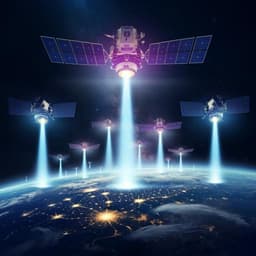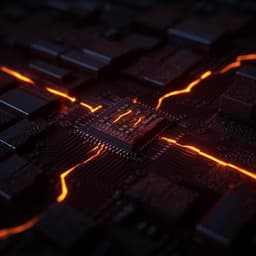
Physics
Proposal for space-borne quantum memories for global quantum networking
M. Gündoğan, J. S. Sidhu, et al.
Discover how Mustafa Gündoğan, Jasminder S. Sidhu, Victoria Henderson, Luca Mazzarella, Janik Wolters, Daniel K. L. Oi, and Markus Krutzik are paving the way for global quantum communication. This groundbreaking research showcases the remarkable potential of quantum memory-equipped satellites, promising faster entanglement distribution rates and a roadmap for achieving unconditionally secure communications.
~3 min • Beginner • English
Introduction
The paper addresses how to overcome the fundamental rate–loss limitations of terrestrial quantum communication imposed by exponential attenuation in optical fibres. It explores satellite-based quantum repeaters equipped with quantum memories to enable untrusted, global-scale entanglement distribution and to boost key rates in memory-assisted QKD within line-of-sight distances. The study motivates moving QMs onboard satellites to reduce atmospheric losses, lessen weather dependencies, and improve scalability beyond ~1000 km, surpassing terrestrial repeaters (~4000 km practical limit) and trusted-node satellite relays. The research question is whether and how space-borne QMs can achieve practical, unconditional-security quantum networking over global distances, and what memory and optical link parameters are required.
Literature Review
Methodology
The authors develop quantitative models and simulations for satellite-based quantum repeater (QR) and memory-assisted QKD (MA-QKD) architectures, focusing on low Earth orbit (LEO) configurations and extending to geostationary cases in supplementary materials. They consider first-generation, ensemble-based QM repeater protocols: (i) DLCZ-type protocols with Raman-scattering spin-wave entanglement and (ii) QND-based repeaters where heralding is performed via quantum non-demolition measurements. They compare a hybrid ground–space architecture (satellite sources, ground QMs) with a fully space-based architecture (both QND and QMs onboard satellites) organized in a repeater chain with nesting level n (2^n segments), using satellites carrying pair sources and separate satellites carrying QND+QM modules for entanglement swapping. Entanglement distribution time T_tot serves as the benchmark.
Link and channel models compute losses and noise:
- Diffraction losses for Gaussian beams with initial waist w0 and wavelength λ over distance d, accounting for receiver aperture, with beam divergence Δθ characterized by M^2 (equations analogous to η_dif and Δθ relations).
- Atmospheric losses modeled via zenith transmissivity η_atm and elevation-angle dependence η_atm(θ) = (η_atm)^{secθ}, with parameters informed by MODTRAN; representative zenith transmissivity at 780 nm ~80%.
- Pointing losses modeled with Gaussian pointing error σ_point yielding η_point = exp[-8 σ_point^2/w_0^2].
- Detector dark counts (p_d ≈ 10^-6 per ~1 μs window) and stray light estimated via sky radiance, field-of-view, spectral filtering, and timing window.
Key rate calculations use BB84 secrecy rate R = Y [1 − h(e_x) − h(e_z)]/f with yields and QBERs computed per MA-QKD protocol assumptions (referencing standard formulations). Simulations incorporate realistic telescope sizes (sender 15 cm radius, receiver 50 cm), beam divergences (e.g., 10 μrad case shown), orbital height h = 400 km, average fractional cloud cover fcc = 0.54 (for ground links), detector efficiency, memory efficiencies, number of temporal modes N, number of memory pairs m, and repetition rate R_s (typically 20 MHz). For repeaters, formulas for entanglement distribution time for DLCZ (scaling with nesting level and memory/detection efficiencies) and QND-based protocols (including QND efficiency η_g, source repetition R_s, and two-photon transmission p_0) are used. Performance maps are produced versus link length, beam divergence, and memory efficiency/lifetime for both QR and MA-QKD (uplink/downlink) configurations.
Key Findings
- Fully space-based QND repeater vs hybrid ground–space: For global distances, the fully space-based QND architecture achieves approximately three orders of magnitude faster entanglement distribution than hybrid architectures or DLCZ-style fibre-based repeaters, owing to only two atmospheric traversals and inter-satellite links otherwise in vacuum.
- Storage time requirements: For the fully space-based architecture, required QM storage time is on the order of tens of milliseconds for shorter intercontinental links and ~0.9 s for links approaching half Earth’s circumference. In contrast, the hybrid QND protocol would require storage times from ~80 s up to tens of minutes for similar distances, making it impractical within typical satellite passes.
- Sensitivity to beam divergence: QND protocols’ performance degrades strongly with increased beam divergence. A 10 μrad divergence (comparable to Micius) can slow entanglement distribution by ~4 orders of magnitude relative to diffraction-limited (~1 μrad) beams, emphasizing the necessity of high-quality, low-divergence optics.
- Memory efficiency impact: For QND protocols, reducing memory efficiency from ~90% to ~50% can increase entanglement distribution time by roughly six orders of magnitude for representative long-distance links, rendering operations infeasible within LEO pass windows.
- MA-QKD benchmarks (entanglement-based QKD without memory): Model predicts ~0.15 bits/s at 1120 km ground distance with 5.9 MHz repetition, consistent with a reported 0.12 bits/s; with 20 MHz repetition, ~1 bit/s at 1000 km serves as a benchmark.
- Uplink MA-QKD (ground to satellite, QM at satellite): With 20 MHz operation, single-mode memories (storage ~5–25 ms, ~80% write–read efficiency), 15 cm/50 cm telescopes and 10 μrad divergence (neglecting turbulence/shower-curtain), the protocol yields a speedup over no-memory ent-QKD up to ~1450 km; below ~5 ms dephasing, no meaningful key rate; memory efficiency dependence is moderate (e.g., ~20 ms storage and ~50% write efficiency can exceed benchmark key rates by >10×). This geometry cannot be extended to a repeater chain due to the photon travel direction.
- Downlink MA-QKD (satellite to ground, QM at satellite): Single memory pair (m=1) is speed-of-light limited by classical heralding; seconds-long storage is needed. With a temporally multimode memory (N≈1000), a storage time of ~7.5 s enables key-rate enhancement of about an order of magnitude for 500–1000 km line-of-sight. At 1000 km, storage <~5 s yields negligible key; ~35% storage efficiency combined with ~10 s storage can reach ~10 Hz key rate.
- Downlink with multiple memory pairs: Replacing the central pair with m=100 memory pairs (and N=1000 temporal modes) reduces the required storage time to ~100 ms to achieve similar key rates and ranges as the single-pair, seconds-long memory case; performance cutoff occurs at only a few milliseconds storage time.
- Weather robustness: Incorporating realistic cloud cover (average fcc ≈ 0.54) across multiple ground stations shows hybrid repeater schemes become impractical, while space-based QMs retain performance, highlighting the importance of moving QMs onboard satellites.
Discussion
The findings directly tackle the central challenge of overcoming rate–loss limitations and trusted-node dependencies in global quantum communications. By locating QMs and QND modules onboard satellites, the architecture minimizes atmospheric channels and weather dependencies, thereby achieving superior scaling of entanglement distribution and enabling untrusted, global networking. The strong improvement in entanglement distribution times (up to three orders of magnitude) indicates feasibility for planetary-scale links within LEO pass durations, addressing the bottleneck faced by terrestrial repeaters and hybrid schemes. The MA-QKD analyses reveal operational regimes where QMs provide clear key-rate advantages over no-memory protocols, and quantify the conditions (memory lifetime, efficiency, multimode capacity, and number of memory pairs) that make downlink and uplink schemes practical. Sensitivity analyses underscore that low beam divergence and high memory efficiency are critical, offering concrete engineering targets. Overall, the results demonstrate that space-borne QMs can robustly enhance both entanglement distribution and QKD, providing a path to device-independent security and integration with ground networks.
Conclusion
The paper proposes and quantitatively evaluates space-borne quantum memories for global quantum networking, demonstrating that a fully space-based QND repeater architecture outperforms hybrid ground–space and DLCZ-style protocols by up to three orders of magnitude in entanglement distribution rate over global distances. For line-of-sight communications, MA-QKD with QMs on satellites substantially boosts key rates, with downlink performance becoming practical using multimode memories and/or multiple memory pairs to relax storage-time requirements from seconds to sub-second or tens of milliseconds. The work offers clear benchmarks on optical link quality, memory efficiency, and lifetime, and outlines candidate memory platforms and implementation pathways leveraging current or near-term technologies. Future research directions include optimizing orbital dynamics and constellation designs for entanglement distribution, engineering network topologies to exploit modest coherence-time memories, and analyzing finite-size effects and time-window constraints in satellite passes.
Limitations
- Practical performance is highly sensitive to optical beam quality; increased divergence (e.g., 10 μrad) can degrade rates by several orders of magnitude, necessitating precise optics and pointing/tracking.
- Memory efficiency and coherence time are critical; QND-based repeaters require high efficiencies (≈90%) and, for some MA-QKD schemes, seconds-long storage unless compensated by multimode capacity and multiple memory pairs.
- Weather constraints: While the fully space-based approach reduces weather impacts, end links still depend on ground station conditions; hybrid architectures become especially fragile under realistic cloud cover across many stations.
- Uplink MA-QKD suffers additional atmospheric loss (“shower-curtain” effect), requiring larger space-borne receivers and potentially limiting range.
- Limited satellite pass durations in LEO impose tight timing constraints; slow protocols or low-efficiency memories may be impractical within available contact windows.
- Noise sources (dark counts, stray light) and atmospheric turbulence, while modeled, can vary significantly with operational conditions and may necessitate additional filtering and system complexity.
- First-generation, postselection-based repeaters do not employ active error correction, limiting ultimate rates and distances compared to future QR generations.
Related Publications
Explore these studies to deepen your understanding of the subject.







